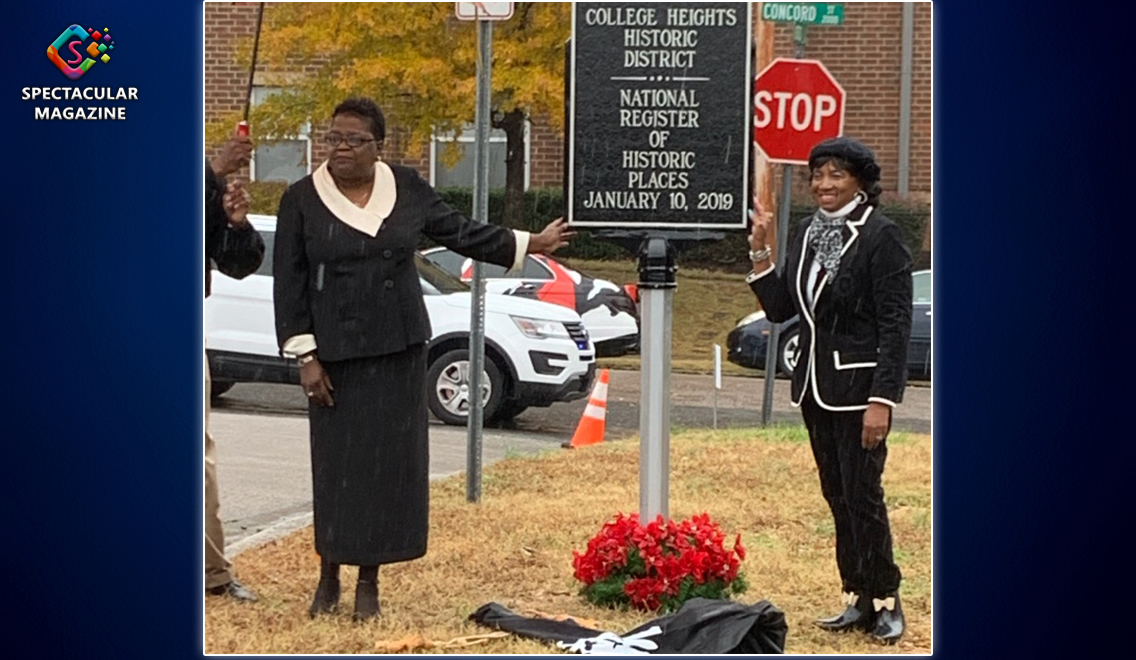College Heights Historic District Host Unveiling Ceremony
Durham, NC – On November 23, 2019, College Heights Historic District unveiled its marker commemorating its designation in the National Register of Historic Places awarded by the United States Department of Interior on January 10, 2019. The program organizers, Beverly Barnes Evans and Melva George Rigel, ensured that many stories of College Heights were told.
This African American neighborhood had been long overlooked for its great contributions to the history of Durham as well as the nation. The event was quite educational for some of the attendees and newer residents. Even on a very rainy and cold day, there was a great showing of support from elected city and county officials, state and federal dignitaries, other invited guests, former and current residents, and the general public. The uniqueness of this neighborhood was summarized due to time constraints, yet its significance was not lost on this worthwhile occasion.
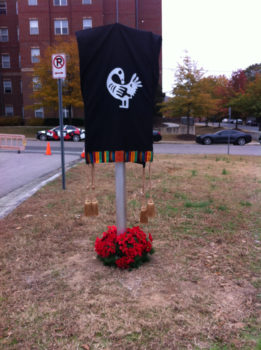
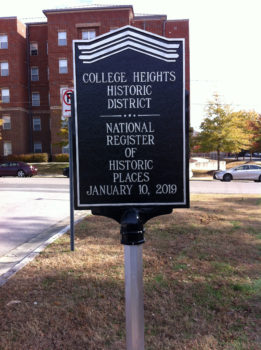 The marker covering was a unique choice as well. The bird on the front of the marker covering is that of the Sankofa bird. Sankofa is a word in the Twi language of Ghana that translates to “Go back and get it” and also refers to the Asante Adinkra symbol represented either with a stylized heart shape or by a bird with its head turned backward while its feet face forward carrying a precious egg in its mouth. In its use for this event, The head turned backward indicates the acknowledgment of the vision and wisdom of their parents and ancestors; and the feet moving forward means that the children are moving forward with the wisdom they have learned and are carrying on the legacy in extraordinary ways.
The marker covering was a unique choice as well. The bird on the front of the marker covering is that of the Sankofa bird. Sankofa is a word in the Twi language of Ghana that translates to “Go back and get it” and also refers to the Asante Adinkra symbol represented either with a stylized heart shape or by a bird with its head turned backward while its feet face forward carrying a precious egg in its mouth. In its use for this event, The head turned backward indicates the acknowledgment of the vision and wisdom of their parents and ancestors; and the feet moving forward means that the children are moving forward with the wisdom they have learned and are carrying on the legacy in extraordinary ways.
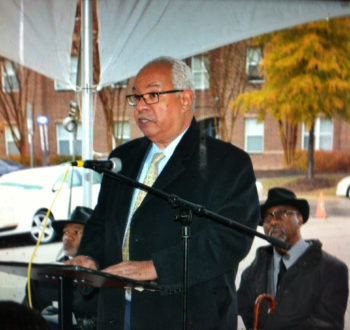
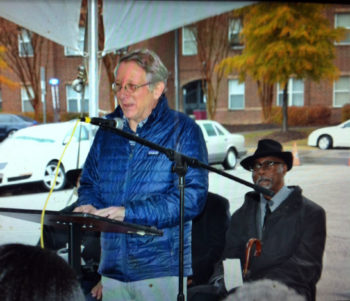
The program began with the invocation by Rev. Dr. Reginald Van Stephens, Pastor – White Rock Baptist Church. The speakers at the ceremony were: Steve Schewel, Mayor – City of Durham; James A. Stewart, Chairman of the Board – M&F Bank (former College Heights resident); Dr. Johnson O. Akinleye, Chancellor – North Carolina Central University; and the Honorable H.M. “Mickey” Michaux, a former College Heights resident and the longest-serving member of the North Carolina General Assembly prior to retiring after 43 years in 2019. The program ended, prior to the unveiling, with the benediction by Rev. Dr. W.C. Turner, Pastor – Mt. Level Missionary Baptist Church.
The College Heights District begins at Fayetteville Street and Formosa Avenue, traveling southbound on Fayetteville Street to Cecil Street. The streets comprising the neighborhood, other than Formosa and Fayetteville are Masondale Avenue, Nelson, Otis and Cecil Streets, Pekoe Avenue, Duncan, and Concord Streets. There are five entrances into the district and all entrances will have an identical marker as unveiled at the ceremony.
Neighborhood residents included the second president of the college, Alphonso Elder, thirty-six professors, one janitor, one HVAC maintenance person, and one groundskeeper supervisor, all employees of North Carolina College, later renamed North Carolina Central University.
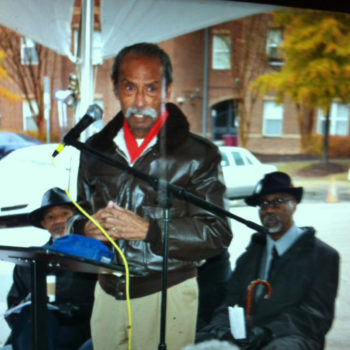
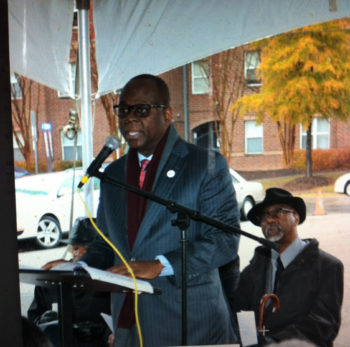
There were also twenty-eight employees of North Carolina Mutual, including its President Joseph Goodloe, thirty-two independently owned entrepreneurs, forty public school teachers, four principals, three pastors, the first African American postman in Durham, six policemen/detectives, one dentist, three doctors, four registered nurses, two attorneys, one judge, W.G. Pearson, whose father was a philanthropic trustee of North Carolina College, one Mechanics and Farmers Bank President, John Hervey Wheeler as well as, other notable professionals.
There are twelve buildings on North Carolina Central University’s campus named after residents of College Heights. They are:
- William H. Robinson Science Building, (1937). Dr. William H. Robinson of 210 Formosa Street was Chairman of the Physics Department and taught physics from 1937-1962. The building now houses the Josephine Dobbs Clement Early College High School. He also did blueprints for some of the neighbors’ homes that were built.
- Helen Gray Edmonds Classroom Building, (1950). Dr. Helen Gray Edmonds of 118 Nelson Street was Chairwoman of the History Department and Social Sciences, and Dean of the Graduate school of Arts and Sciences.
- James T. Taylor Education Building, (1955). Dr. James T. Taylor of 2106 Fayetteville Street taught Psychology from 1926-1943.
- James W. Younge Tennis Courts, (1955). Dr. James W. Younge of 104 Masondale Avenue was a physical education professor, Athletic Director and Tennis Coach from 1949-1975. He won five CIAA Championships, four in the MEAC and two in the National Association of Intercollegiate Athletics and one in the NCAA Eastern Region. He was inducted into the NCCU, MEAC and CIAA Halls of Fame. His wife Eugenia was an NCCU English Professor.
- James S. Lee Biology Building, (1956). Dr. James Sumner Lee of 130 Nelson Street was Chairman of the Biology Department from 1938-1963.
- Alphonso Elder Student Union, (1968). Dr. Alphonso Elder of 406 Formosa was a Math Professor, Dean of the Undergraduate School from 1948-1963 and the Second President of the University.
- Hubbard-Totten Chemistry Building, (1969). Dr. Ezra Totten of 2105 Duncan Street taught Chemistry and made the Department flourish becoming the Chair in 1949, retiring in 1976.
- Josephine Dobbs Clement Early College High School, (1970). Josephine Dobbs Clement 206 Pekoe Street, was appointed to the County Charter Commission, was a member of the school board, became Chair and finally a County Commissioner. The school was designed to offer a rigorous curriculum including college courses leading up to two years of college credit to increase students who will pursue advanced studies and careers in Science, Technology, Engineering, and Mathematics.
- O’Kelly-Riddick Stadium, (1974). Herman Riddick of 2010 Otis Street was a Biology Professor, Track and Field Coach, Head Football Coach from 1945-1964. He was CIAA Coach of the Year in 1945, 1953, 1954, 1961 and 1963.
- O’Kelly-Riddick Track and Practice Field, (since demolished) Herman Riddick was the Track and Field Coach from 1945-1964.
- Albert L. Turner Law Building, (1980). Dr. Albert L. Turner of 114 Nelson Street was hired in 1941 and a year later became the Dean of the Law School until 1965, boosting enrollment and made innumerable contributions.
- H. M. Michaux, Jr. School of Education Building, (2000). H. M. Michaux, Jr. of 408 Formosa, is an NCCU Alumnus, Law School graduate and Civil rights Leader becoming the longest member of the North Carolina House of Representatives, known as the Dean of the House, serving forty-three years. He also served three terms as the National President of the NCCU Alumni Association as well as terms as a member of the Board of trustees and the Board of Directors of the NCCU Foundation, Inc.
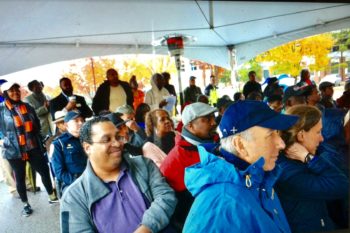
There are too many children of the original homeowners to name who attended and/or graduated from North Carolina Century University or other universities and reached heights. The neighborhood stressed the importance of higher education and making an impact via hard work and setting goals.
With just this small glimpse, you can understand the significant history that the College Heights community contributed to the betterment of African American history and all of mankind.


